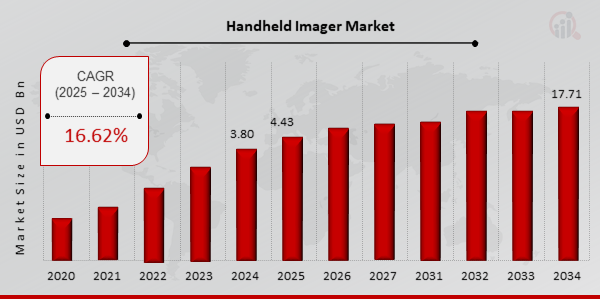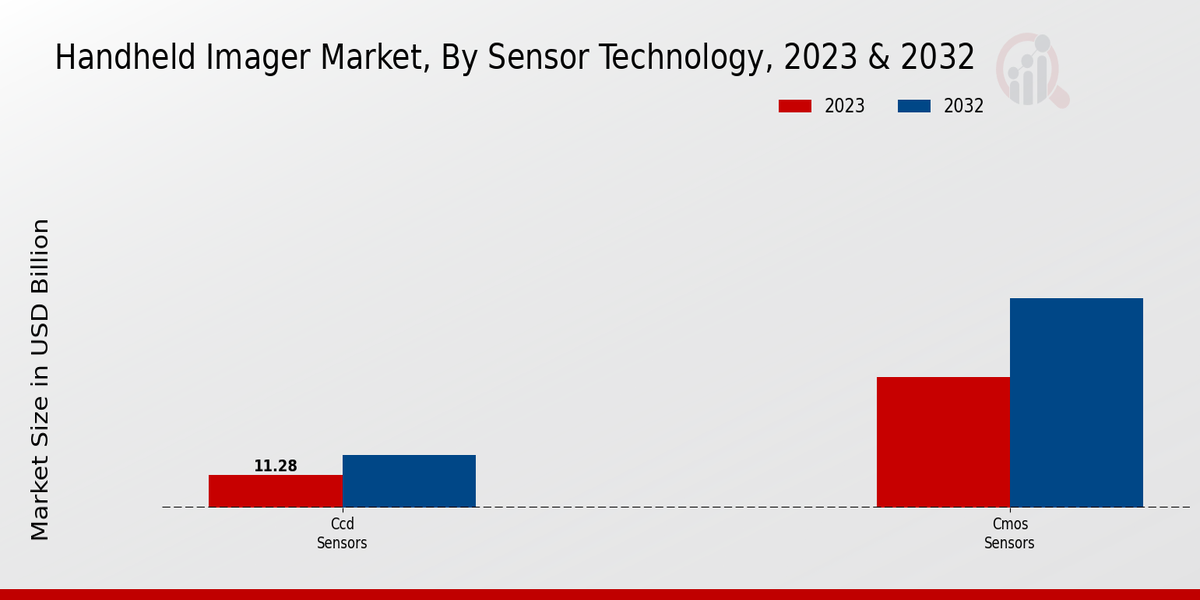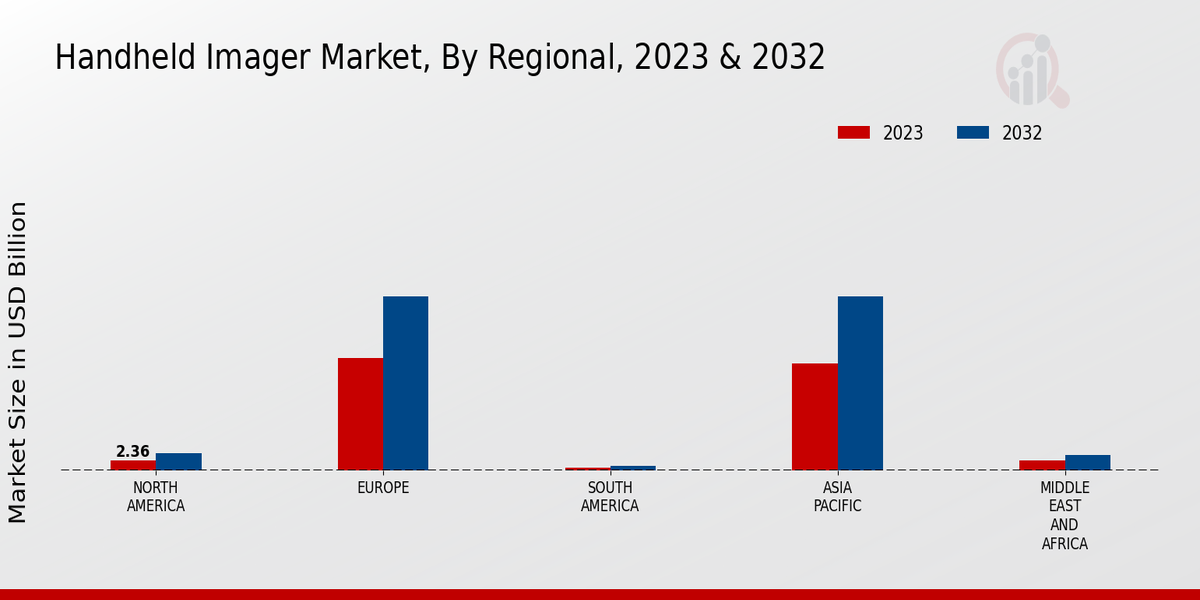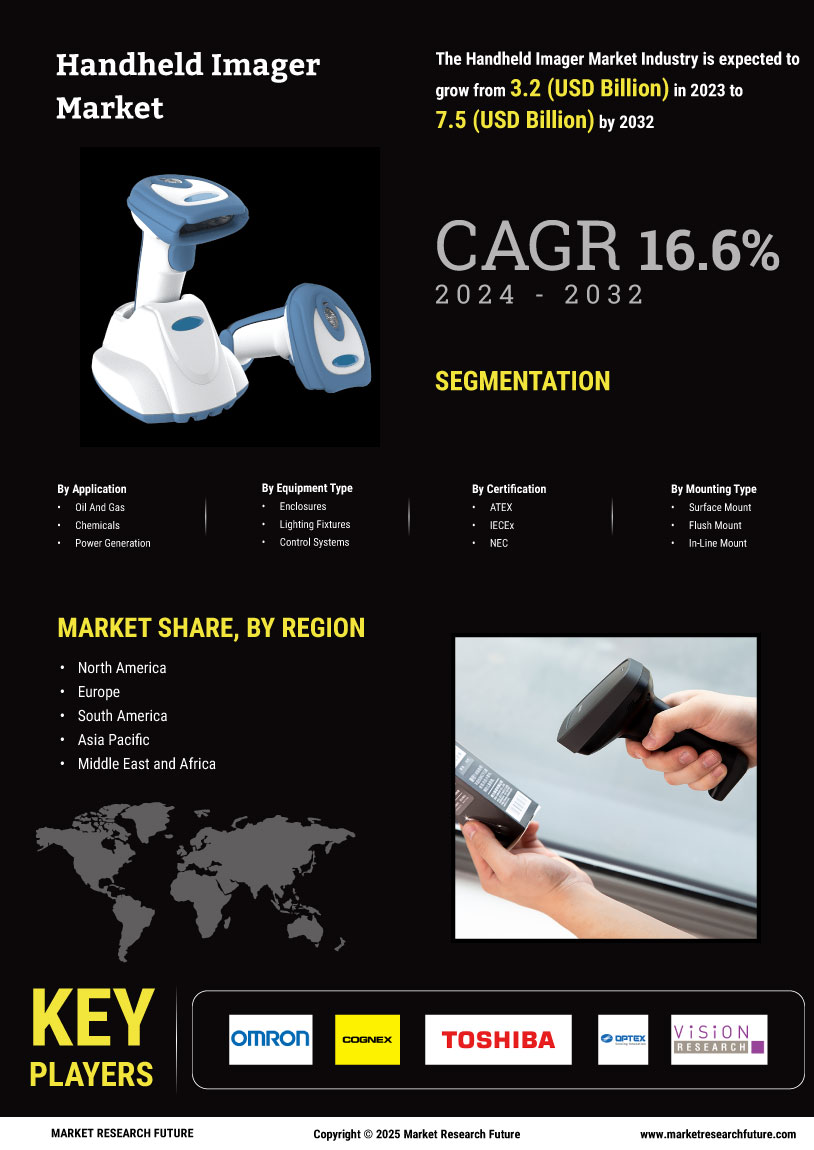Global Handheld Imager Market Overview:
The Handheld Imager Market Size was estimated at 3.80 (USD Billion) in 2024. The Handheld Imager Market Industry is expected to grow from 4.43 (USD Billion) in 2025 to 17.71 (USD Billion) till 2034, exhibiting a compound annual growth rate (CAGR) of 16.62% during the forecast period (2025 - 2034).
Key Handheld Imager Market Trends Highlighted
Increased requirements for handheld imagers are influenced by the increasing need for automated data capture and barcode scanning systems in retail, healthcare, and logistics industries. The growing popularity of mobile point-of-sale (POS) solutions and the rise in e-commerce have led to an increase in demand for handheld imagers.
The key areas for growth in the handheld imager market include the expansion of the retail sector, especially in developing countries and focus on supply chain efficiency. Furthermore, the integration of emerging technologies like artificial intelligence (AI) and the Internet of Things (IoT) into handheld imagers creates new avenues for market growth.
Some emerging trends witnessed within handheld imager markets include the development of ruggedized models designed specifically for harsh environments, the production of smaller, lighter-weight imagers that are more portable, and multi-modal scanning encompassing 1D, 2D along RFID. It is also worth noting that the market sees a rising preference for advanced capabilities such as high-resolution cameras, large touch screens or wireless connectivity.

Source: Primary Research, Secondary Research, MRFR Database and Analyst Review
Handheld Imager Market Drivers
Rising Demand for Enhanced Traceability and Inventory Management in Supply Chains
The increasing need for efficient and accurate tracking of goods throughout supply chains is driving the demand for handheld imagers. These devices enable businesses to automate data capture processes, reducing errors and improving inventory visibility. As supply chains become more complex and globalized, the ability to track items from origin to destination is crucial for ensuring product quality, maintaining compliance, and optimizing inventory levels.Handheld imagers play a vital role in fulfilling these requirements, contributing to the growth of the Handheld Imager Market Industry.
Advancements in Imaging Technology and Data Analytics Capabilities
The continuous advancements in imaging technology and data analytics capabilities are enhancing the functionality and value proposition of handheld imagers. Improved image sensors, higher resolution, and faster processing speeds enable these devices to capture and process data more efficiently. Additionally, advancements in data analytics software allow businesses to extract valuable insights from the data collected by handheld imagers. These insights can be used to optimize operations, improve decision-making, and gain a competitive advantage.
Growing Need for Automation in Warehouses and Distribution Centers
The increasing demand for fast and efficient fulfillment of orders is driving the adoption of automation in warehouses and distribution centers. Handheld images play a crucial role in automating processes such as receiving, put-away, picking, and shipping. By automating these tasks, businesses can improve productivity, reduce labor costs, and enhance order accuracy. Moreover, the integration of handheld imagers with warehouse management systems and other software applications further enhances their value and contributes to the growth of the Handheld Imager Market Industry.
Handheld Imager Market Segment Insights:
Handheld Imager Market Sensor Technology Insights
The Handheld Imager Market segmentation by Sensor Technology includes CCD (Charge-Coupled Device) Sensors and CMOS (Complementary Metal-Oxide-Semiconductor) Sensors. CCD sensors have been the traditional choice for handheld imagers due to their high image quality and low noise. However, CMOS sensors are becoming increasingly popular due to their lower power consumption, smaller size, and lower cost. The CMOS sensor market is expected to grow at a CAGR of 9.5% from 2024 to 2032, reaching a market size of USD 25.77 billion by 2032.
The growth of the CMOS sensor market is attributed to the increasing demand for handheld imagers in various applications, such as retail, healthcare, and manufacturing.The CCD sensor market is expected to grow at a CAGR of 5.3% from 2024 to 2032, reaching a market size of USD 13.45 billion by 2032. The growth of the CCD sensor market is attributed to the increasing demand for high-quality images in applications such as medical imaging and scientific research. Overall, the Handheld Imager Market is expected to grow at a CAGR of 6.5% from 2024 to 2032, reaching a market size of USD 88.55 billion by 2032. The growth of the market is attributed to the increasing adoption of handheld imagers in various applications, such as retail, healthcare, and manufacturing.

Source: Primary Research, Secondary Research, MRFR Database and Analyst Review
Handheld Imager Market Resolution Insights
The resolution segment plays a crucial role in defining the capabilities and applications of handheld imagers. The 'Less than 1 MP' resolution category caters to basic scanning needs, offering affordability and portability. The '1 to 5 MP' segment finds widespread adoption in retail, healthcare, and logistics, providing a balance between image quality and cost-effectiveness. The 'More than 5 MP' resolution category caters to specialized applications requiring high-precision imaging, such as document scanning and industrial inspection. As per market data, the '1 to 5 MP' resolution segment is projected to witness significant growth in the coming years due to its versatility and cost-effectiveness, driving the overall Handheld Imager Market growth.
Handheld Imager Market Application Insights
The Handheld Imager Market segmentation by Application offers valuable insights into the industry's diverse applications. In 2023, the Retail and Logistics segment held the largest market share, driven by the increasing demand for efficient inventory management and supply chain optimization. The Manufacturing and Industrial segment is projected to grow significantly as handheld imagers enhance production processes and quality control.
The Healthcare segment presents substantial growth potential, with handheld imagers aiding in patient identification, medication administration, and medical imaging. The Security and Surveillance segment is gaining traction due to the rising need for enhanced security measures and crime prevention. The Others segment includes applications in various industries such as hospitality, transportation, and education. Overall, the segmentation analysis provides a comprehensive understanding of the Handheld Imager Market, enabling stakeholders to identify potential opportunities and tailor their strategies accordingly.
Handheld Imager Market Form Factor Insights
The Handheld Imager Market segmentation by Form Factor into Pistol Grip, In-line, Ring, and Others offers crucial insights into the market dynamics. The Pistol Grip segment held the largest market share in 2023, accounting for nearly 45.3% of the Handheld Imager Market revenue. Its ergonomic design and ease of use make it popular in various industries. The In-line segment is projected to grow at a steady CAGR of 5.6% during the forecast period, owing to its compact size and suitability for applications requiring high precision. Ring-type handheld imagers, with their wearable design, are gaining traction in industries like healthcare and logistics, contributing to a market share of 12.9% in 2023. The Others segment, which includes specialized form factors like pen-type and fixed-mount imagers, is expected to witness significant growth due to increasing adoption in niche applications.
Handheld Imager Market Connectivity Insights
The connectivity segment plays a crucial role in the adoption and usage of handheld imagers. The connectivity options available in the market primarily include Wired (USB, RS-232), Wireless (Bluetooth, Wi-Fi), and NFC (Near Field Communication). Wired connectivity, such as USB and RS-232, offers a stable and reliable connection between the imager and the host device. It is commonly used in industrial and enterprise settings where data accuracy and security are critical. Wired connectivity ensures minimal latency and interference, making it suitable for applications that require real-time data transmission.
Wireless connectivity, including Bluetooth and Wi-Fi, provides greater flexibility and mobility. Bluetooth enables short-range wireless communication, allowing handheld imagers to connect to nearby devices such as smartphones or tablets. Wi-Fi, on the other hand, offers a wider range of connectivity and can connect to networks for data transmission. Wireless connectivity is ideal for applications that require the imager to be used in different locations or where physical cables are impractical.
NFC connectivity allows for contactless data exchange between the handheld imager and compatible devices. It is often used in applications such as mobile payments, access control, and inventory management. NFC provides a quick and convenient way to transmit data without the need for physical contact. The choice of connectivity depends on factors such as the application, environment, and required level of security. Wired connectivity offers stability and reliability, while wireless connectivity provides flexibility and mobility. NFC offers a convenient and contactless solution for specific applications.
Handheld Imager Market Regional Insights
The regional segmentation of the Handheld Imager Market presents a diverse landscape with varying market dynamics. North America holds a significant market share, driven by factors such as technological advancements, high adoption rates in industries such as retail and healthcare, and the presence of key market players. Europe follows closely behind, with a substantial market share attributed to the region's mature economies, strong industrial base, and growing demand for automated data capture solutions. APAC is projected to witness the fastest growth over the forecast period, owing to the rapid adoption of handheld imagers in emerging economies like China, India, and Southeast Asia. South America and MEA exhibit potential for growth as well, with increasing demand from various industry verticals and government initiatives aimed at improving efficiency and productivity.

Source: Primary Research, Secondary Research, MRFR Database and Analyst Review
Handheld Imager Market Key Players And Competitive Insights:
Major players in the Handheld Imager Market industry are continuously striving to develop innovative products to meet the changing demands of customers. Leading Handheld Imager Market players are focusing on research and development to enhance the features and functionalities of their products. The Handheld Imager Market industry is characterized by intense competition among the leading players.
The competitive landscape of the Handheld Imager Market is expected to remain highly competitive in the coming years, with new entrants and established players vying for market share. Zebra Technologies is a leading provider of handheld imagers, offering a wide range of products designed for various applications. The company's products are known for their durability, reliability, and performance. Honeywell is another major player in the Handheld Imager Market, offering a comprehensive portfolio of products that cater to different industry verticals. The company's focus on innovation and customer satisfaction has helped it establish a strong position in the market.
Datalogic is a prominent player in the Handheld Imager Market, specializing in the design and manufacture of high-performance data capture devices. The company's products are widely used in retail, healthcare, and logistics industries. Cognex is a leading provider of machine vision and image processing solutions, including handheld imagers. The company's products are known for their precision, speed, and reliability. SICK AG is a renowned manufacturer of sensors, safety systems, and machine vision solutions, including handheld imagers. The company's products are used in a wide range of industries, including manufacturing, logistics, and transportation. These companies are constantly investing in research and development to improve their products and services, which is expected to further intensify competition in the Handheld Imager Market.
Key Companies in the Handheld Imager Market Include:
-
Omron
-
Cognex
-
Toshiba Tec
-
Optex
-
Vision Research
-
SICK
-
Zebra Technologies
-
Microscan
-
Neology
-
Honeywell
-
Keyence
-
Datalogic
-
Panasonic
-
Banner Engineering
Handheld Imager Market Industry Developments
The Handheld Imager Market is anticipated to witness significant growth over the forecast period. Rising demand for handheld imagers in various industries, including retail, healthcare, and manufacturing, is a key driver of this growth. The increasing adoption of mobile technology and the need for efficient data collection and processing are also contributing to the market's expansion. Recent news developments in the handheld imager market include the launch of new products with advanced features and the expansion of distribution channels by key players. For instance, in 2023, Zebra Technologies introduced the TC78 handheld imager, which offers enhanced scanning capabilities and improved ergonomics. Additionally, companies are focusing on strategic partnerships and acquisitions to strengthen their market position and expand their product portfolio.
Handheld Imager Market Segmentation Insights
Handheld Imager Market Sensor Technology Outlook
- CCD (Charge-Coupled Device) Sensors
- CMOS (Complementary Metal-Oxide-Semiconductor) Sensors
Handheld Imager Market Resolution Outlook
- Less than 1 MP
- 1 to 5 MP
- More than 5 MP
Handheld Imager Market Application Outlook
- Retail and Logistics
- Manufacturing and Industrial
- Healthcare
- Security and Surveillance
- Others
Handheld Imager Market Form Factor Outlook
- Pistol Grip
- In-line
- Ring
- Others
Handheld Imager Market Connectivity Outlook
- Wired (USB, RS-232)
- Wireless (Bluetooth, Wi-Fi)
- NFC (Near Field Communication)
Handheld Imager Market Regional Outlook
- North America
- Europe
- South America
- Asia Pacific
- Middle East and Africa
|
Report Attribute/Metric
|
Details
|
|
Market Size 2024
|
USD 3.80 Billion
|
|
Market Size 2025
|
USD 4.43 Billion
|
|
Market Size 2034
|
USD 17.71 Billion
|
|
Compound Annual Growth Rate (CAGR)
|
16.62% (2025-2034)
|
|
Base Year
|
2024
|
|
Market Forecast Period
|
2025-2034
|
|
Historical Data
|
2020-2023
|
| Market Forecast Units |
USD Billion |
| Key Companies Profiled |
Omron, Cognex, Toshiba Tec, Optex, Vision Research, SICK, Zebra Technologies, Microscan, Neology, Honeywell, Keyence, Datalogic, Panasonic, Banner Engineering. |
| Segments Covered |
Sensor Technology, Resolution, Application, Form Factor, Connectivity, Regional. |
| Key Market Opportunities |
Growing e-commerce industryIncreasing adoption in healthcareDemand for mobile and wireless devicesAdvancements in image recognition technologyRising need for inventory management |
| Key Market Dynamics |
Rising Demand for AutomationAdvancements in Image Sensor TechnologyGrowing E-commerce and Retail SectorGovernment Support for DigitizationEmergence of 5G Technology |
| Countries Covered |
North America, Europe, APAC, South America, MEA |
Frequently Asked Questions (FAQ) :
The Handheld Imager Market is projected to reach a valuation of approximately USD 3.80 billion in 2024.
By 2034, the Handheld Imager Market is anticipated to reach an impressive valuation of around USD 17.71 billion.
The Handheld Imager Market is estimated to exhibit a steady growth trajectory with a CAGR of 16.62% during the forecast period from 2025 to 2034.
North America region is anticipated to hold a significant market share and is projected to continue its dominance throughout the forecast period.
Handheld Imagers find widespread applications across various sectors, including retail, healthcare, manufacturing, logistics, and transportation, among others.
Zebra Technologies, Honeywell, Datalogic, Cognex, and SICK AG are some of the prominent players operating in the Handheld Imager Market.
Factors such as the increasing adoption of e-commerce, the growing need for efficient inventory management, and the rising demand for automation in various industries are driving the growth of the Handheld Imager Market.
The Handheld Imager Market faces challenges related to technological advancements and the availability of low-cost imitations in the market.
Opportunities for growth in the Handheld Imager Market lie in the increasing penetration of wireless technologies and the adoption of advanced imaging technologies.
Key trends shaping the Handheld imaging market include the adoption of 2D and 3D imaging technologies, the integration of artificial intelligence, and the growing use of handheld imagers in healthcare and logistics applications.

















